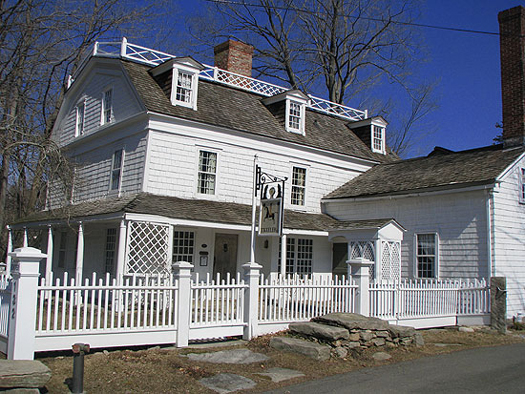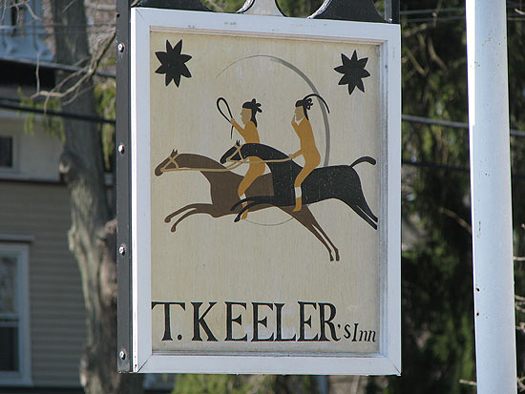| |
Taverns
of the Colonial Period

The
layout of a typical tavern in colonial times had several small
rooms and one large room on the main level. In many cases
houses were converted into taverns, formal living rooms became
parlors where lady travelers could rest and dining rooms became
taprooms where beer and cider were served. The larger room,
what we consider a "family room" or "great room" today, was
usually located at the front of the tavern and was used as
the main dining room. This main dining room was filled with
a mixture of small and large tables, typically it had a fireplace
and several comfortable chairs around it. The main room was
also used for meetings, court hearings, and social gatherings.
The tavern's sleeping quarters were located upstairs. In the
early days, it wasn't uncommon for visitors to share rooms
or even a bed. Later, private rooms were added to some taverns,
similar to Bed and Breakfasts/Inns of the present day. The
kitchen location varied, in some cases it was in the back
of the house, in others downstairs in the basement, a separate
building out back was possible too. Behind the tavern, there
was an outhouse or backhouse (i.e. bathroom) and often a stable
where travelers could rest their horses.
Almost
all colonial taverns were located on main highways or turnpikes.
Signs were essential and since many people in colonial times
could not read, a sign with a picture was a necessity. Tavern
signs were often carved from wood, but some were also painted
on plaster or cast in metal. In the Revolutionary period the
name of the tavern sometimes reflected the allegiance of it's
tavern keeper. A tavern named, The King's Arms, indicated
an allegiance to England. A tavern named The Washington Tavern,
indicated the tavern keeper sided with the American patriots.
In
colonial times a night's stay at a tavern, including meals,
lodging and stable space for the traveler's horse might cost
about $2.00. Here are the prices charged by one colonial tavern:
Lodging - $.12 ½, Breakfast - $.37 ½, Dinner - $.50, Supper
- $.37 ½, Lodging for the horse - $.50.
An
introduction from Nancy L. Struna's Transforming the Ordinary:
A Social History of Taverns, 1750-1820s, best states what
taverns meant to the local communities they served in the
days of the Revolution:
"In
the middle of the 18th century, taverns lay at the center
of life in the British American mainland colonies. People
ate, drank, and slept there; they read mail and papers and
in other ways got the news; they boarded stages from and voted
at taverns; they attended court hearings and committed crimes.
Tavern keepers themselves were often respected and influential
citizens, and tavern keeping was viewed as an important and
economically viable occupation, including for women. As a
point of fact, taverns were everywhere, they housed everything,
and everyone could be involved. They were the social and cultural
centers of colonial life."
The
colonial government found taverns so important to development
of this new land they enacted laws to encourage their construction.
Because
of their great importance to the community, every innkeeper
in Connecticut had to be recommended by the selectmen and
civil authorities, constables and grand jurors of the town
in which he resided, and then licensed at the discretion of
the Court of Common Pleas.
1759
Addition to the Law entitled- Act for Licensing and Regulating
Houses of Public Entertainment or Taverns:
"Whereas
in said law it is enacted that the civil authority, selectmen,
constables and grand-jury-men in the respective towns of this
Colony shall, sometime in the month of January, annually,
nominate the person or persons whom they or the major part
of them think fit and suitable to keep a house or houses of
public entertainment in the said town for the ensuing year,
which nomination shall be sent to them to the next county
court in that county, which court shall grant licenses to
the said persons and to no others…"
Below
are two descriptions of tavern keepers in the Revolutionary
period:
He
was often a magistrate, the chief of a battalion of militia
or even a member of a state legislature. He is almost always
a man of character, for it is difficult for any other to obtain
a license to exercise the calling.
The
landlord was usually a politician, sometimes a rank demagogue.
He often held public office, was selectman, road commissioner,
tax assessor, tax collector, constable, or town moderator;
occasionally he performed all these duties. They were most
frequently soldiers, either officers in the militia or brave
fighters who had served in the army. It was a favorite calling
for Revolutionary soldiers. They were usually cheerful men;
a gloomy landlord made customers disappear like flowers before
a frost.
Redding
Ridge's tavern owner, Stephen Betts, certainly fits the profile:
Lieutenant
Stephen Betts, was a prominent character in the Revolution.
He was an active patriot, and was taken prisoner by the British
on their march to Danbury in April, 1777. A County Convention
was held at his house/tavern on August 10, 1779.
Betts
was prominent in town politics, serving as Town Selectman
during the Revolution, as well as several town committees
formed in support of the war.
General
Samuel H. Parsons was headquartered at Betts' home/tavern
from 1778 to 1781.
Among
the other benefits of having a tavern in a rural community
was its essential role in attracting volunteers for the local
"trainband" or "militia". As stated above, the tavern owner
was "often a magistrate, the chief of a battalion of militia
or even a member of a state legislature." The reason a chief
of a battalion of militia made a good tavern keeper is a fine
example of "Yankee Ingenuity". In the colonial period, a local
"trainband" or "militia" was the only protection the citizens
of these rural settlements had against their biggest risk:
being raided by native American Indians; coastal settlements
mustered militia's to counter potential aggressions from the
Dutch. The problem with relying on a militia was inconsistency
in the numbers, ability and experience of its members. The
militiamen were volunteers and as is the case with any volunteer
operation, militia leaders faced the problem of how to increase
their numbers and more importantly how to get their "troops"
to attend mandatory training days once they did join. Service
in the militia didn't pay, so why go drill? The obvious answer
was: to learn how to maneuver as a unit, shoot accurately,
and defend a position, but most militia members weren't swayed
by that reasoning. That's where "Yankee Ingenuity" and taverns
came into play: free beer on drill day. By underwriting a
couple kegs of beer at the local tavern on drill day, able
bodied "militiamen" turned out in droves. It was amazing how
effective, in terms of recruiting, a little free ale could
be.
The
most famous Revolutionary Tavern, still standing in close
proximity to Redding, Connecticut is: The Keeler Tavern
in Ridgefield, Connecticut. During the Revolution, landlord
Timothy Keeler was a well known patriot, suspected of manufacturing
musket balls in the basement of his tavern. The British poured
a special fire upon the building in April of 1777, lodging
one cannon ball into the north side of the house (still can
be seen by drawing aside the shingle that usually conceals
it). A companion cannon ball whistled so close to a man who
was climbing the stairs of the house that he tumbled down
backward screaming, "I'm a dead man, I'm a dead man!" until
his friends with some difficulty silenced him, and assured
him he was still alive. A son of the landlord, Jeremiah Keeler,
enlisted in the Continental army at the age of seventeen;
he became a sergeant, and was said to be the first man to
scale the English redoubts at Yorktown; He was presented with
a sword by his commanding officer, Marquis de Lafayette, for
his efforts. When Lafayette made his triumphal passage through
the United States in 1824, a festive reception was held at
the tavern in his honor.

If
you'd like to view photos and learn more about colonial taverns,
these sites have a good amount of information.
|

